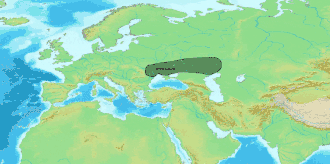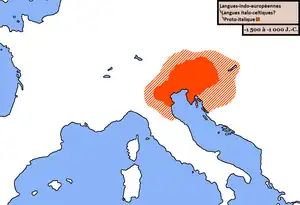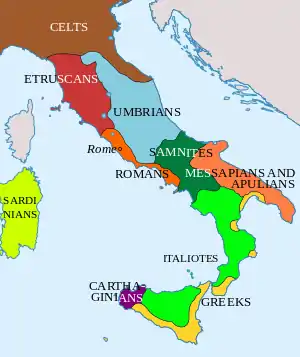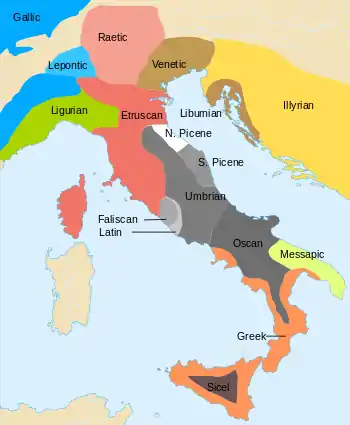| Part of a series on |
| Indo-European topics |
|---|
 |
This list of ancient Italic peoples includes names of Indo-European peoples speaking Italic languages or otherwise considered Italic in sources from the late early 1st millennium BC to the early 1st millennium AD.
Ancestors
%252C_The_Horse%252C_The_Wheel_and_Language.jpg.webp)
Map 1: Indo-European migrations as described in The Horse, the Wheel, and Language by David W. Anthony

Map 2: Possible area of origin and migration route of Proto-Italic speaking people towards Italian peninsula

Map 3: Ethnicities of today's Italy in 400 BC. The Italic tribes lived at this point in the south-central part of the Italian peninsula.

Map 4: Ethnolinguistic map of Italy in the Iron Age, before the Roman expansion and conquest of Italy

Map 5: The linguistic and peoples landscape of Central Italy at the beginning of Roman expansion
- Proto-Indo-Europeans (Proto-Indo-European speakers)
- Proto-Italics (Proto-Italic speakers)
Latino-Faliscans
- Falisci
- Capenates (in Capena and Ager Capenas, Capena land)
- Falerii (in Falerii and Ager Faliscus)
- Sardinia Falisci (in and around Peronia, northeastern Sardinia)
- Aborigines (mythology) (Casci Latini) - Latium Sicels
- Prisci Latini (Old Latins) (according to tradition and legend they were formed by the merger of Aborigines and Latium Sicels)
- Latini[1][2] (Latins (Italic tribe))
- Abolani
- Aesulani
- Acienses
- Albans (Albani) (Populi Albenses) (in Alba Longa Land, between the modern-day Lake Albano and Monte Cavo)
- Antemnates (in Antemnae) (sometimes regarded as Sabines)
- Bolani / Bovillani
- Bubetani
- Cusuetani (originally Latin tribe that was conquered and assimilated by the Volsci)
- Coriolani, Old / Old Coriolani (originally Latin tribe that was conquered and assimilated by the Volsci)
- Ficani (in Ficana Land)
- Latin Fidenates (originally Latin tribe that was conquered and assimilated by the Etruscans, for some centuries Fidenates were Etruscans - the Fidenates Etruscans, however in the 8th century BC, Rome, after a war with Veii and Fidenae, conquered Fidenae and established a Roman Latin colony there - Fidenae Novae, and the Fidenae land was Latinized again)[3]
- Foreti / Foretii
- Hortenses
- Latinienses / Romans (Romani) (Ancient Romans) (originally in Rome and Ager Romanus or Ager Latinienses, Roman land, later throughout the Roman Empire)
- Roman tribes (originally there were three tribes: Luceres, Ramnes and Tities, later with Roman expansion increased to 35)
- Roman gentes (sing. gens - clan) (originally they were only Roman Latins, but later, with Roman expansion, several clans of other peoples were also included, such as the Sabines, Etruscans and other Italics)
- Roman tribes (originally there were three tribes: Luceres, Ramnes and Tities, later with Roman expansion increased to 35)
- Longulani (originally Latin tribe that was conquered and assimilated by the Volsci)
- Macrales
- Manates
- Munienses
- Mutucumenses
- Numinienses
- Octulani
- Olliculani
- Pedani
- Polluscini (originally Latin tribe that was conquered and assimilated by the Volsci)
- Querquetulani
- Sicani, Latium (Latium Sicani) (not to be confused with the Sicily's Sicani)
- Sisolenses
- Tolerienses (in Toleria or Tolerium Land)
- Tutienses
- Velienses
- Venetulani, Latium / Latium Venetulani (may have been an originally Venetian tribe that was Latinized and assimilated)
- Vimitellarii
- Vitellenses
- Latini[1][2] (Latins (Italic tribe))
- Prisci Latini (Old Latins) (according to tradition and legend they were formed by the merger of Aborigines and Latium Sicels)
- Opici
Osco-Umbrians / Sabellians
- Umbrians
- Oscans
- Alfaterni (in Salerno region)
- Aurunci (may have been the same people as the Ausones but with a different cognate name; Rhotacism: s > r)
- Ausones (may have been the same people as the Aurunci but with a different cognate name)
- Campanians (Campani)
- Frentani (sometimes classified as Samnites, who they were originally descended from)
- Lucanians
- Marrucini
- Paeligni
- Picentini (in Picentini Mounts)
- Samnites (Safineis)
- Sidicini
- Vestini
Other possible Italic peoples
Veneti
Usually they are included as an Italic people by many scholars. However other scholars argue that they could have been a transitional people between Celts and Italics, a Celticized Italic people or a Para-Celtic people.
- Carni? (may have been a Celtic tribe)
- Catali
- Catari
- Histri
- Iapydes
- Liburnians (Liburni)[4]
- Alutae (chief town: Aluus or Aloiis)
- Assesiates
- Buni
- Burnistae
- Caulici
- Curictae (on the island of Curicta, now Krk)
- Encheleae
- Fertinates
- Flanates (chief town: Flanona, which gave name to the Sinus Flanaticus)
- Hymani (or Ismeni)
- Hythmitae
- Lacinienses
- Lopsi (chief town: Lopsica, now Sveti Juraj)
- Mentores
- Olbonenses
- Peucetiae
- Stlupini
- Syopii
- Varvarini (chief town: Varvaria)
- Secusses
- Subocrini
- Veneti Proper
- Venetulani
See also
References
- ↑ Barthold Georg Niebuhr (1845). The History of Rome, Volume 1, p. 154.
- ↑ Gary D. Farney, Guy Bradley, eds. (2017). The Peoples of Ancient Italy, P. 478.
- ↑ Barthold Georg Niebuhr (1845). The History of Rome, Volume 1, p. 154.
- ↑ Š. Batović, Liburnska kultura, Matica Hrvatska i Arheološki muzej Zadar, Zadar, 2005, UDK: 904 (398 Liburnija), ISBN 953-6419-50-5, pages 64-66
Further reading
- Gianna G. Buti e Giacomo Devoto, Preistoria e storia delle regioni d'Italia, Sansoni Università, 1974
- Giovanni Pugliese Carratelli, Italia, omnium terrarum alumna, Officine grafiche Garzanti Milano, Garzanti-Schewiller, 1990
- Giacomo Devoto, Gli antichi Italici, 2a ed. Firenze, Vallecchi, 1951.
- Gary D. Farney, Guy Bradley (edits.) (2018). The Peoples of Ancient Italy. Boston, Berlin: Walter de Gruyter.
- Sabatino Moscati, Così nacque l'Italia: profili di popoli riscoperti, Società editrice internazionale, Torino 1998.
- Niebuhr, Barthold Georg. (1835). The History of Rome. Philadelphia: Thomas Wardle
- Francisco Villar, Gli Indoeuropei e le origini dell'Europa, Bologna, Il Mulino, 1997. ISBN 88-15-05708-0
- Vittore Pisani, Lingue preromane d'Italia. Origini e fortune, 1978.
External links
- - Strabo's work The Geography (Geographica). Books 5 and 6 are about Italy (each region has a chapter).
This article is issued from Wikipedia. The text is licensed under Creative Commons - Attribution - Sharealike. Additional terms may apply for the media files.